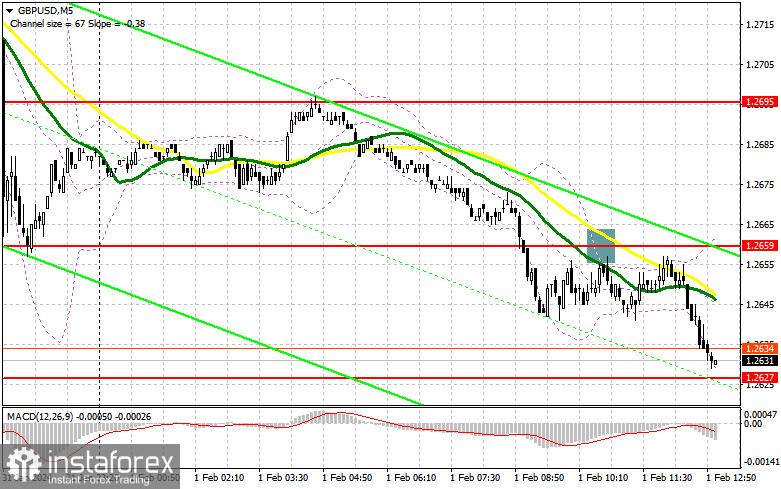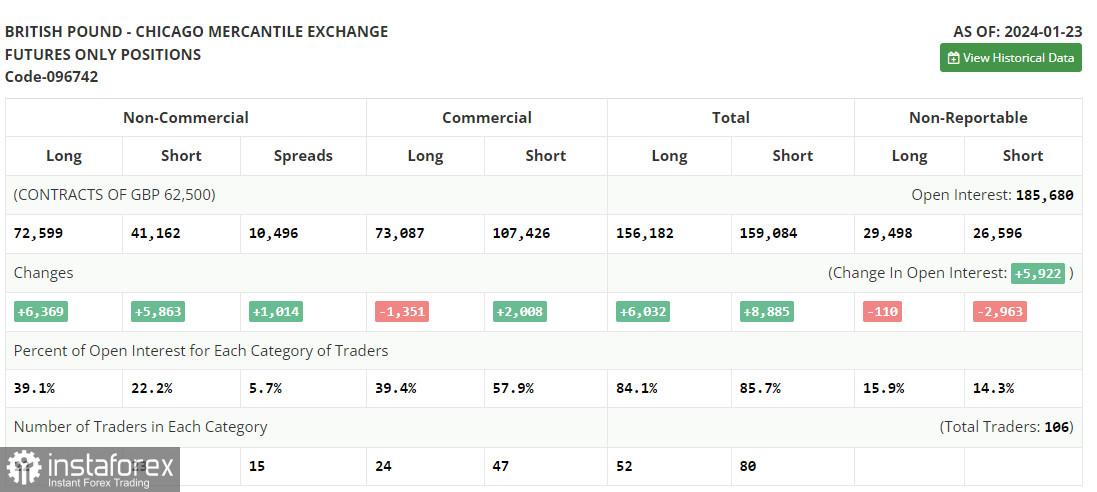In my morning forecast, I drew attention to the level of 1.2659 and planned to make trading decisions based on it. Let's look at the 5-minute chart and analyze what happened. The breakout and retest of this range, which the pair tried three times to approach, all led to a selling signal with a downward movement towards 1.2627. The technical picture was revised for the second half of the day.

To open long positions on GBP/USD:
Pressure on the pair increased after it became clear that the manufacturing activity index in the UK for January was worse than the preliminary value. Considering how nervously the Bank of England reacts to bad data, many traders and economists are confident that the regulator will cut rates soon. However, Bank of England Governor Andrew Bailey contradicts this. Ahead is the regulator's decision, which I detailed in the morning forecast. As for US data, attention should be paid to the number of initial jobless claims, the ISM manufacturing index, and changes in non-farm labor productivity in the non-manufacturing sector. If there are no significant changes, the pressure on the pair will likely persist in the second half of the day.
Considering that the pound continues to fall, I plan to act on the buy side only after a decline and the formation of a false breakout around 1.2627, which will provide an excellent entry point for long positions, counting on a recovery of the pair towards the resistance at 1.2659. However, reaching this level will only be possible in the case of a very tough regulator position. Breaking and consolidating above this range will strengthen demand for the pound and open the way to 1.2695, where the moving averages intersect. The ultimate target will be a maximum of 1.2721, where I plan to make a profit. In the scenario of a pair decline and the absence of bull activity at 1.2627 in the second half of the day, the development of a bearish market will continue. In this case, I will postpone purchases until testing 1.2598. Only a false breakout there will confirm the correct entry point. I plan to buy GBP/USD immediately on a rebound from the minimum of 1.2580, with a correction target of 30-35 points within the day.
To open short positions on GBP/USD:
Sellers have actively made themselves known, and now I await further development of the bearish scenario. If demand for the pound returns after the Bank of England meeting, I will act on the sell side around 1.2659, similar to what I discussed above. The formation of a false breakout there will confirm the presence of large players in the market and lead to the opening of short positions with a target for a decrease towards 1.2627 – support, which we have not reached today. Breaking and retesting this range from bottom to top is very important, as it will strike the bull positions, leading to stop-loss hunting and opening the way to 1.2598. The ultimate target will be the area of 1.2580, where profit will be fixed. With an upward movement of GBP/USD and the absence of activity at 1.2659 in the second half of the day, buyers will again take the initiative, returning trading to a sideways channel. In this case, I will postpone sales until a false breakout at 1.2695. If there is no downward movement, I will sell GBP/USD immediately on a rebound from 1.2721, but only counting on a pair correction down by 30-35 points within the day.


Indicator Signals:
Moving Averages:
Trading is below the 30 and 50-day moving averages, indicating a potential decline in the pound.
Bollinger Bands:
In the event of a decline, the lower boundary of the indicator will act as support around 1.2627.
Description of Indicators:
- Moving Average (MA) - A trend indicator that shows the current trend by smoothing volatility and noise. Period 50. Marked on the chart in yellow.
- Moving Average (MA) - A trend indicator that shows the current trend by smoothing volatility and noise. Period 30. Marked on the chart in green.
- Moving Average Convergence/Divergence (MACD) - A trend-following momentum indicator that shows the relationship between two moving averages of a security's price. Fast EMA period 12. Slow EMA period 26. SMA period 9.
- Bollinger Bands - Volatility indicator consisting of a middle band being an N-period simple moving average (SMA), an upper band at K times an N-period standard deviation above the middle band, and a lower band at K times an N-period standard deviation below the middle band.
- Non-commercial traders - speculators such as individual traders, hedge funds, and large institutions that use the futures market for speculative purposes and meet specific requirements.
- Long non-commercial positions represent the total long open position of non-commercial traders.
- Short non-commercial positions represent the total short open positions of non-commercial traders.
- The total non-commercial net position is the difference between non-commercial traders' short and long positions.





















